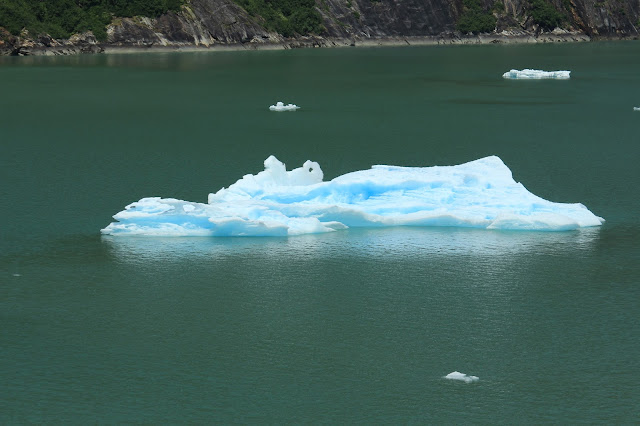 |
| Not always. When the wind blows off the ice it will cut right through you |
The two above actually have names. If you've read any of my other blogs, you'll know that there's very little chance I can remember their names. The fact that they have names means that, by Alaskan standards, they're really really big mountains. This monster is 18,000 feet tall (it's actually Mt Elias - thank God for Google). Unless it can impress an Alaskan, they don't bother naming them. They just refer to them by their elevation. Good ole 8,431. While Mt Elias is only 18,000 feet high (only?) in my opinion, it looks bigger than Mt Everest.
I think.
I've never seen Everest. But here's were I'm coming from. Everest is 29,029 feet high, but at the lowest base camp you're already at 18,000 feet before you see it. The way I calculate it - you only see Everest as 11,000 feet tall. Of, course, at 18,000 feet there's so little oxygen that you will probably also see Elvis is your porter.
Well, you anyway. There's now way in hell I'm climbing up 18,000 feet just for the view. Lemme know when the tram gets installed and I'll have a go at it.
Even without knowing what mountain you're looking at, you can get a feel for it's height.
The trick is to remember that Alaska was covered by ice in the not too distant past. The ice was usually around 4,000 feet deep. Ice carves up and smooths out stone mountains with ease. It takes a while, but in the end the ice always leaves it's mark. Looking at the mountain directly ahead of the foremast, I'd guess it to be about 7,000' tall.
This is an example of what stone sculpting by ice looks like up close.
Speaking of ice (good segue huh?), I took several hundred pictures of floating ice (they make great slide show screen savers for the computer, but REALLY boring blogs). Floating ice comes from calving glaciers (in this part of Alaska anyway). They're broken into 5 main categories.
- Icebergs (height above water over 16 feet)
- Bergie bits (3 to 16 feet)
- Growlers (less than 3 feet)
- Brash ice (even smaller - to be avoided if you're kayaking)
- Ice cubes (able to fit in bar glasses, never to be avoided)
 |
| This is a growler. I named it the Usain Bolt. |
 |
| This is brash ice |
 |
| This is a Bergie bit. We named it the Arizona Memorial |
 |
| This is the Little Mermaid Bergie bit |

 |
| They make for good perching. |
 | ||||
| Or sun bathing, if you're so inclined.
All sea ice is best viewed from the deck of a nice, steel, ice-rated ship. They look pretty placid, but they have a nasty habit of rolling over unexpectedly.
This one is about 20' across.
Where bergs come from is the really spectacular show.
Lots of the time good photography requires great patience, good light, good equipment, etc. Sometimes the boat just has to be in the right position.
Cool island with an arch
Elephant Rock
Most of Alaskan water is deep. Apparently not all of it.
Alaskan sanitation workers have a sense of humor.
I like to into bars, but not this one
I'm not a smoker, but these were new one to me (found in a convenience store in Kodiak).
These cigarette extinguishers must be used a lot by fishermen, because there were several different types. Shoulda bought one for a novelty.
Back to the lower 48
|
































No comments:
Post a Comment